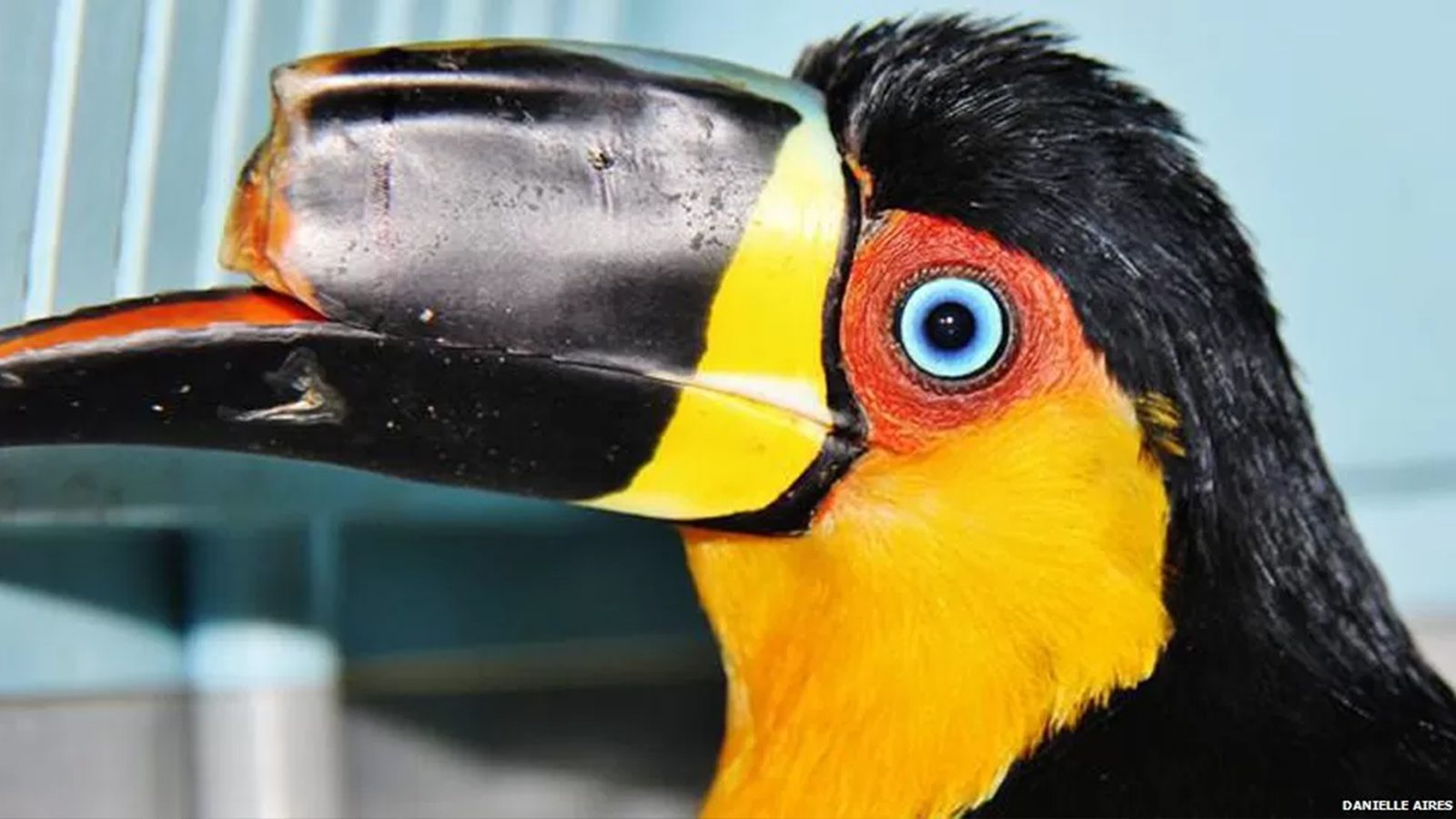A team of scientists and a 3D printer made this abused toucan whole again.
In the heart of Brazil, a tale of resilience and innovation unfolds, painting a vivid picture of how scientists can harness technology to aid in wildlife conservation. This story revolves around a toucan named Tieta, who, after falling victim to the brutalities of illegal wildlife trafficking, found a new lease on life through the wonders of a 3D printer.
The Illegal Wildlife Trade Is Thriving in Brazil
Wildlife trafficking is a significant issue in Brazil, posing a severe threat to the country’s rich biodiversity. Various species, including turtles, fish, jaguars, frogs, insects, primates, songbirds, and parrots, are illegally targeted and removed from their natural habitats. The animal advocacy group, WWF, estimates that 38 million animals are stolen from the forests of Brazil each year, which poses a substantial threat to regional and global biodiversity.
One of the primary threats is the unsustainable take and trade of wildlife. This illegal wildlife trade is often driven by criminal networks that exploit the country’s vast and diverse ecosystems.
Social media and the illegal capture of toucans and other wildlife in Brazil
The use of social media platforms often facilitates wildlife trafficking in Brazil. These platforms provide an easy and anonymous way for traffickers to connect with buyers and sell their illegal goods. In response, authorities are increasingly monitoring these platforms to identify and apprehend those involved in this illicit trade.
Conversely, concerned stakeholders use the same social platforms to launch public awareness campaigns. The goal is to educate users about the devastating impacts of wildlife trafficking. Ultimately, the fight against wildlife trafficking in Brazil requires a comprehensive effort, leveraging technology as a tool for both enforcement and education.

How economic hardship often leads to wildlife trafficking
Furthermore, the COVID-19 pandemic has exacerbated the problem. Economic hardship during the pandemic led to a significant increase in wildlife trafficking. From January to August 2020, traffic stops throughout Brazil led to the recovery of over 25,000 illegally transported exotic animals.
The crisis has highlighted the urgent need for more robust measures to combat wildlife trafficking. In response, Brazilian authorities have ramped up their efforts, implementing stricter controls and increasing penalties for wildlife trafficking. Additionally, there’s a growing emphasis on international cooperation to address this global issue, as wildlife trafficking often crosses national borders.
How Brazilian authorities hope to curb the issue
Ongoing efforts are underway to combat the issue of the illegal capture and trade of native animals. For instance, Brazilian police have turned to nuclear science to fight against wildlife trafficking. This innovative approach allows for identifying the geographic origin of trafficked animals, aiding in their return to their natural habitats, and prosecuting traffickers.
Despite these efforts, wildlife trafficking remains a pervasive problem in Brazil, undermining conservation efforts and economic growth. It is a complex issue demanding a multi-pronged approach, including stronger laws, improved enforcement, increased public awareness, and international cooperation.
About the Toucan Who Needed a New Beak
In the bustling metro area of Rio de Janeiro, a female toucan, Tieta, was discovered in a pitiful state in March of 2015. She was undernourished and had lost the upper part of her beak, a critical tool for her survival. The circumstances surrounding the loss of her beak remain unclear. It could have resulted from a skirmish with another toucan during transportation in a cramped box. Or perhaps she was subjected to the cruelty of ruthless animal traffickers. Nobody really knows for sure.
Regardless of the cause, Tieta’s recovery became a focal point for a wildlife management organization, Instituto Vida Livre. In collaboration with three Brazilian universities, they embarked on a mission to restore Tieta’s lost beak. The solution they arrived at was a testament to the power of technology in the service of wildlife conservation: a 3D-printed prosthetic beak. She underwent groundbreaking surgery on July 27, 2015.
Speaking about a Costa Rican case of a toucan with a severed beak, animal rescue founder Dennis Janik, explained the importance of the beak to this beautiful bird:
“For a toucan, losing the beak is like being without arms, lipless and toothless.”
This case underscores the potential of 3D printing technology in creating prosthetics that can significantly enhance the quality of life for injured animals. Tieta’s new beak, a lightweight plastic prosthesis weighing a mere 4 grams, has made a world of difference to her daily routines. It took about two hours for the 3D printer to craft the prosthetic.
Before receiving her prosthetic beak, Tieta had to toss her food into the air and attempt to catch it with the lower part of her beak. Needless to say, the method was not always successful.
Watch this heartwarming video to see the team attaching her prosthetic:
The Prognosis for Tieta, the Toucan With the Prosthetic Beak
With her new beak, Tieta could easily feed and groom herself. Her prosthetic beak from a 3d printer would also mean mating and caring for her chicks like any other healthy toucan.
However, despite these improvements, Tieta will not return to the wild as she cannot survive independently. Instead, she will reside in an educational zoo. Under their care, her story can serve as a powerful message about the devastating impacts of animal trafficking.
Final Thoughts on the Toucan Who Received a New Beak Courtesy of a 3D Printer
Tieta’s story is a poignant reminder of the urgent need to protect wildlife from illegal trafficking and other harm. It also highlights the potential of technology, such as 3D printing, in aiding wildlife conservation efforts. While it is heartening to see such innovative solutions used to help individual animals like Tieta, it is crucial to remember that the ultimate goal should be to prevent such harm from occurring in the first place.
To achieve this, we need to raise awareness about the devastating impacts of wildlife trafficking. We must also continue to advocate for stronger laws and enforcement to deter such activities. Additionally, we should support organizations that work tirelessly to rescue and rehabilitate wildlife affected by these illegal activities.
No matter how small, every effort can contribute to protecting and preserving our precious wildlife.



















